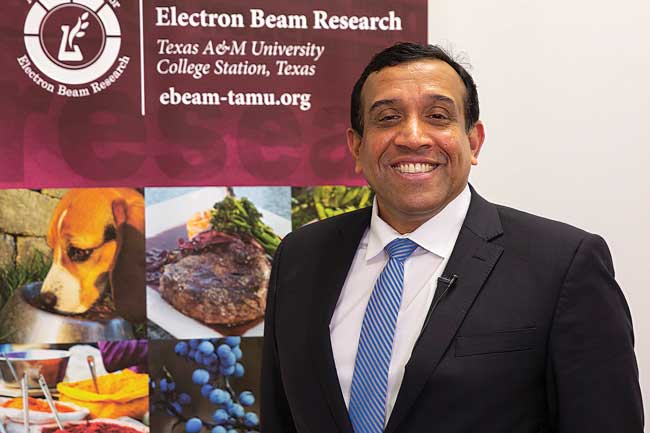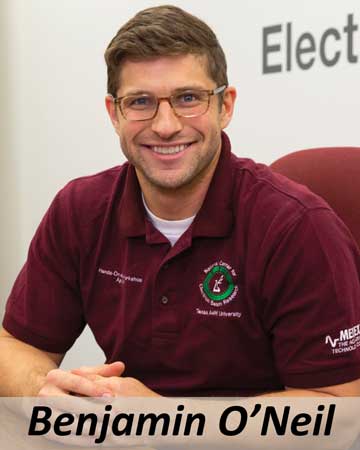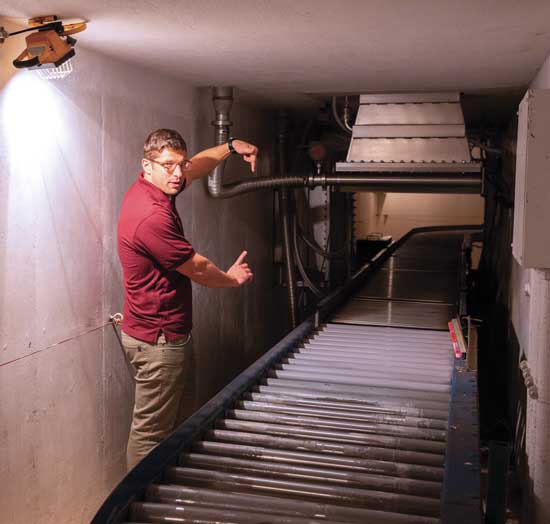E-Beam Technology: To Infinity and Beyond
INSIDE ACADEMIA
Every year, a number of foodborne illness outbreaks are linked to the consumption of fresh fruits and vegetables. In fact, pathogenic microbes on fresh produce account for nearly half of the foodborne illnesses in the United States, yet a technology that could greatly reduce the incidence of foodborne illness in both fresh produce and processed foods is still largely underutilized: electron beam irradiation. Researchers at the National Center for Electron Beam Research at Texas A & M University are working to change that, devising ways to use electron beam technology to improve the safety, quality, and shelf life of foods on this planet and beyond.
 Long before the existence of plants and animals, microbes were the earth’s only inhabitants; they inhabited every surface, fissure, and subsurface of the planet. “People don’t realize that on earth, bacteria have about a 3.8 billion–year head start over humans,” says Suresh Pillai, a professor in the Department of Nutrition and Food Science at Texas A & M and director of the school’s National Center for Electron Beam Research. “In sheer numbers, humans are the contaminants, … not microorganisms. … People forget that there are only 7 billion humans on the earth right now. There are probably 10 billion organisms between our front two teeth. So if you look at sheer numbers, microbes are all around us, within us, … and all over.” With so many microorganisms in existence, pathogenic microbes can exist on food and food sources, in water, and on materials used to produce food packaging. It is therefore inevitable that foodborne illness is a persistent threat around the world. “Also, because of the 3.8 billion-year head start, [microbes] have adapted to almost every single condition that humans can expose them to,” Pillai adds. “If you think back, these organisms had to withstand very cataclysmic conditions during the origins of the earth. Modern humans have been here only 200,000 years. So who has a chance to win?” Probably microbes, but if applications of electron beam technology were adopted more widely, humans would have a greater chance to prevail. Pillai and his team of researchers at the National Center for Electron Beam Research are working on projects to expand the applications of electron beam technology to include food irradiation, pasteurization, and sterilization as well as health and environmental functions.
Long before the existence of plants and animals, microbes were the earth’s only inhabitants; they inhabited every surface, fissure, and subsurface of the planet. “People don’t realize that on earth, bacteria have about a 3.8 billion–year head start over humans,” says Suresh Pillai, a professor in the Department of Nutrition and Food Science at Texas A & M and director of the school’s National Center for Electron Beam Research. “In sheer numbers, humans are the contaminants, … not microorganisms. … People forget that there are only 7 billion humans on the earth right now. There are probably 10 billion organisms between our front two teeth. So if you look at sheer numbers, microbes are all around us, within us, … and all over.” With so many microorganisms in existence, pathogenic microbes can exist on food and food sources, in water, and on materials used to produce food packaging. It is therefore inevitable that foodborne illness is a persistent threat around the world. “Also, because of the 3.8 billion-year head start, [microbes] have adapted to almost every single condition that humans can expose them to,” Pillai adds. “If you think back, these organisms had to withstand very cataclysmic conditions during the origins of the earth. Modern humans have been here only 200,000 years. So who has a chance to win?” Probably microbes, but if applications of electron beam technology were adopted more widely, humans would have a greater chance to prevail. Pillai and his team of researchers at the National Center for Electron Beam Research are working on projects to expand the applications of electron beam technology to include food irradiation, pasteurization, and sterilization as well as health and environmental functions.
Food Irradiation
The term “food irradiation” has many negative connotations and often invokes images of workers in hazmat suits, wearing specialized breathing masks and producing radioactive food that glows, but that is a highly inaccurate depiction. Food irradiation is a process that involves using ionizing radiation to improve the safety and extend the shelf life of foods; it does not make foods radioactive. “Ionizing radiation is … radiation that has the capacity to ionize atoms and cause the release of electrons,” Pillai explains. The process, which harnesses the power of high-energy electrons to break chemical bonds, can serve many purposes in the food system: preventing foodborne illness, preserving food, controlling or eliminating insects on imported foods, delaying sprouting or ripening, and sterilizing foods for special populations. In a sense, food irradiation is a form of pasteurization—albeit nonthermal—for nondairy solid foods.
Food irradiation is safe, has been in use for more than 50 years, and is permitted in more than 55 countries around the world. In the United States, food irradiation has been approved for beef, pork, and poultry; crustaceans (lobster, shrimp, and crab) and shellfish (oysters, clams, mussels, and so on); fresh vegetables and fruits, including lettuce and spinach; wheat and seeds for sprouting; herbs and spices; and shell eggs. The U.S. Food and Drug Administration has approved three radiation sources for use on foods: gamma rays from radioactive isotopes such as Cobalt-60 or Cesium-137, x-rays, and electron beam technology. Regard-less of the irradiation method, food is usually packaged before it is irradiated. Right now, the most commonly used radiation source for food is Cobalt-60. “I like to [compare] Cobalt-60 radiation technology to what I would consider to be like the carburetor technology of automotive cars and electron beam and x-ray technologies to be the more modern version[s],” Pillai asserts. “It’s not that there’s something wrong with Cobalt-60 radiation, [but] in today’s world it makes no sense to use an older technology.”
X-ray and electron beam technologies are newer methods of food irradiation, and they are more precise. Irradiating foods with Cobalt-60 involves exposing foods to the radioisotope as it emits gamma rays (i.e., radiation) while it spontaneously disintegrates. To irradiate foods with x-ray technology, x-rays are produced by reflecting a high-energy stream of electrons off a heavy metal into foods. To irradiate foods with electron beam technology, a stream of high-energy electrons from a commercial electric source are propelled into food. “In very simplistic terms, we take electrons from commercial electricity from any power source,” Pillai clarifies. “Electricity is made of electrons. We take each of those electrons and accelerate them to 99.99% of the speed of light. When you accelerate those electrons to that high speed, they pick up a lot of energy. That energy is harnessed to break the DNA [of microorganisms].” Both x-ray irradiation and electron beam irradiation allow precise dose delivery of radiation to foods, which is one of the advantages they have over the use of Cobalt-60. “Even on a package of food, you can control the location where you actually can put the electrons or x-rays down (primarily the electrons),” Pillai says. But in terms of the actual radiation, electron beam is the most precise of the three ionizing radiation technologies.
 Pasteurization and Sterilization
Pasteurization and Sterilization
Not only is electron beam technology a more precise way to irradiate food, but it can be used for a variety of other purposes. “E-beam [is] known as a cold pasteurization. That basically means we can expose food packages to ionizing radiation to reduce the microbial bioburden of the package,” says Benjamin O’Neil, a graduate student in the Department of Nutrition and Food Science at Texas A & M and a member of Pillai’s research team. “The common method right now for industry to pasteurize food would be some sort of thermal process. … E-beam is different. … By removing the heat, we can actually increase the quality [of foods] while still achieving the same desired outcome of reducing microbial populations. … We are reducing the organisms in a food package to help extend the shelf life of foods.” The effect that ionizing radiation from electron beam technology has on bacteria, fungi, and other microorganisms is it destroys or damages their DNA; this either kills the microbes or renders them incapable of multiplying. Rachel McNicholas, a graduate student in the Department of Nutrition and Food Science at Texas A & M and a member of Pillai’s research team, is investigating the use of electron beam irradiation to pasteurize fruits and vegetables. “I think that fruits and vegetables … should be pasteurized [because] there are so many different points of contamination that could possibly happen,” McNicholas says. “Also, a lot of fruits and vegetables spoil pretty quickly.” One objective of her research is to develop minimally processed produce that has a longer shelf life and that can be dispensed via vending machines. “The shelf life of produce is really short,” McNicholas explains. “By using pasteurization, [we] can eliminate some of those microbes that might accumulate or increase some of [the] quality and sensory attributes that consumers look for.”
 Pasteurization reduces the number of pathogenic and spoilage microorganisms in foods, but to eliminate all of them, foods must be sterilized. O’Neil is investigating the use of electron beam technology to sterilize foods. “A big part of what I do is sterilization and finding new ways to achieve sterilization,” O’Neil reveals. “We’re focusing on freeze-dried foods because [freeze-drying] is a nonthermal process, and then we’re going to couple it with another nonthermal process [through which] we can improve the quality and safety of foods specifically for [certain populations].” Astronauts in space eat only foods that have been sterilized, and hospital patients with severely impaired immune systems (e.g., individuals with AIDS or those undergoing chemotherapy) would also benefit from a diet of sterilized foods. “We study the inactivation of [the] worst-case scenario … organisms that would be present in berries as well as some that would be highly resistant to e-beam processing,” O’Neil says. “Then we could determine what sort of dose we would need to sterilize a product. And then also part of the research is [that] once we know what doses we need to achieve sterility, how confident can we be, and what kind of chemical changes are being induced [by] e-beam processing.”
Pasteurization reduces the number of pathogenic and spoilage microorganisms in foods, but to eliminate all of them, foods must be sterilized. O’Neil is investigating the use of electron beam technology to sterilize foods. “A big part of what I do is sterilization and finding new ways to achieve sterilization,” O’Neil reveals. “We’re focusing on freeze-dried foods because [freeze-drying] is a nonthermal process, and then we’re going to couple it with another nonthermal process [through which] we can improve the quality and safety of foods specifically for [certain populations].” Astronauts in space eat only foods that have been sterilized, and hospital patients with severely impaired immune systems (e.g., individuals with AIDS or those undergoing chemotherapy) would also benefit from a diet of sterilized foods. “We study the inactivation of [the] worst-case scenario … organisms that would be present in berries as well as some that would be highly resistant to e-beam processing,” O’Neil says. “Then we could determine what sort of dose we would need to sterilize a product. And then also part of the research is [that] once we know what doses we need to achieve sterility, how confident can we be, and what kind of chemical changes are being induced [by] e-beam processing.”
 Protecting U.S. Agriculture
Protecting U.S. Agriculture
At lower doses, electron beam technology can be used as a method to extend shelf life by inhibiting seeds, grains, and root vegetables from sprouting or ripening, and it can be used as a phytosanitary measure to protect U.S. agriculture from invasive insects and other pests on imported vegetables and fruits. “At the lowest doses [of e-beam technology], you have phytosanitary treatment,” says Sohini Bhatia, a graduate student in the Department of Nutrition and Food Science at Texas A & M and another member of Pillai’s research team. “We’re looking at combining electron beam with a couple other food processing techniques to create fresh fruits and vegetables that have a longer shelf life.” Electron beam irradiation is one of several methods that can be used to control invasive pests, but according to Pillai, it is not as widely utilized in this capacity as it could be. Most imported commodities undergo either hydrothermal treatment (i.e., hot water immersion) or methyl bromide fumigation. “Hot water treatment is extremely damaging to … fruit. You cannot use it on fruit[s] with a particular sugar profile. Also, there is the potential of Salmonella contamination through hot water treatment. There have been a number of instances where Salmonella in mangoes has come from hot water treatment,” Pillai asserts. “Methyl bromide is … used worldwide for controlling insects and pests. [It] is a toxic chemical both from residues remaining on the fruit and from occupational safety.” Because of its toxicity, the use of methyl bromide is banned except to prevent introducing invasive insects, nematodes, fungi, weeds and other pests on imported commodities to the United States. The use of electron beam technology for phytosanitary treatment would reduce or eliminate occupational exposure to methyl bromide and other chemical alternatives.
 Pillai and his research team are working with entomologists and experts at the U.S. Department of Agriculture (USDA) Animal and Plant Health Inspection Service (APHIS) to develop pest control technologies that incorporate electron beam irradiation. USDA APHIS experts have set certain doses of radiation for irradiation quarantine disinfestation of imported commodities without harming the products. Phytosanitary irradiation is designed to achieve one of the following endpoints: death, inactivation, or sterility (inability to reproduce) of pests, depending on the regulatory endpoint. However, if the treatment objective of the phytosanitary irradiation is sterility, then live insects will still be present on commodities. When officers visually inspect imported vegetables and fruits, there is no way for them to know whether the insects have been irradiated. In conjunction with entomologists at Texas A & M, Pillai and his research team have developed a technology that will enable officers and inspectors to determine whether an insect has been irradiated. “Why is that important? It is important because we believe there’s going to be a time when people are going to counterfeit irradiation symbols,” Pillai predicts. “So there needs to be some sort of a verification program.”
Pillai and his research team are working with entomologists and experts at the U.S. Department of Agriculture (USDA) Animal and Plant Health Inspection Service (APHIS) to develop pest control technologies that incorporate electron beam irradiation. USDA APHIS experts have set certain doses of radiation for irradiation quarantine disinfestation of imported commodities without harming the products. Phytosanitary irradiation is designed to achieve one of the following endpoints: death, inactivation, or sterility (inability to reproduce) of pests, depending on the regulatory endpoint. However, if the treatment objective of the phytosanitary irradiation is sterility, then live insects will still be present on commodities. When officers visually inspect imported vegetables and fruits, there is no way for them to know whether the insects have been irradiated. In conjunction with entomologists at Texas A & M, Pillai and his research team have developed a technology that will enable officers and inspectors to determine whether an insect has been irradiated. “Why is that important? It is important because we believe there’s going to be a time when people are going to counterfeit irradiation symbols,” Pillai predicts. “So there needs to be some sort of a verification program.”
The electron beam center is also involved in the development of vaccines for food animals. One of Bhatia’s research projects involves developing vaccines for poultry. “The vaccine I’m working on is for Clostridium perfringens, which is the second most [common] cause of foodborne illness in the United States,” Bhatia says. C. perfringens typically resides in the intestines of chickens and other food animals. When chickens are processed, the raw meat often becomes contaminated with C. perfringens. “If you prevent chicken from having a growth of this bacteria in their gut, it leads to fewer contamination cases,” Bhatia says. The vaccine is made by exposing the pathogen to a dose of electron beam irradiation that inactivates the microbial organism. “So the pathogens aren’t completely killed, but their DNA is completely damaged, [so] it’s still intact,” Bhatia reveals. “You [thus] have antigenic markers and immunogenic markers still on the surface. If you were to give that to an animal or a human, [the animal or human] would have an immune response.”
To Irradiation and Beyond
Other potential applications for electron beam research are wastewater treatment, drinking water treatment, novel food packaging materials, and necessities for long-duration space missions (food, clothing, etc.). “The National Center for Electron Beam Research was originally designed for food pasteurization research, food safety, and food quality, but we’ve evolved [beyond] that,” Pillai says. Despite all the potential uses for electron beam irradiation, it is still largely underutilized. In most countries where food irradiation is permitted, it is accomplished with Cobalt-60 gamma irradiation, and sterilization of food for astronauts in space is accomplished by either high-heat thermal processing or Cobalt-60 gamma irradiation. “[Cobalt-60] is being used around the world, and it is being used around the world quite effectively,” Pillai says, but he points out that electron beam technology has several advantages over Cobalt-60. “Cobalt-60 cannot be switched off, so it’s like buying a big block of dry ice,” Pillai reasons. “If you don’t use it, you will lose it. With electron beam, the big advantage is [that] it’s a switch-on and switch-off technology. [And] the cost of treating a commodity with Cobalt-60 is more expensive than [the cost] of treating it with electron beam.” Perhaps the most glaring issue with the widespread use of Cobalt-60 is the security risk of its availability. “Radioactive isotopes like Cobalt-60 … are risk factors for … dirty bombs,” Pillai warns. “Worldwide, the U.S. government is spending a significant amount of money to reduce the reliance on Cobalt-60 and Cesium-137 for commercial use.
“If the industry is serious about improving the quality and the safety of foods in their entirety, then this is the technology to use,” Pillai says. He envisions a world where electron beam technology is integrated into the food processing system before products are packaged. “That’s where we want to go, where this technology [is] integrated into [the] food production system so that there is no need for companies to package the food and then ship these products hundreds of kilometers away to an irradiation facility,” Pillai says. “Our guiding principle is to harness electrons for cleaning, healing, feeding, and shaping this world and beyond. It is up to the creativity of the researcher [or the industry] on how to harness this technology.” In the competent hands of Pillai and his research team, there is no doubt that the uses of electron beam technology will continue to expand and evolve to make the world a safer place.
Toni Tarver is senior technical editor of Food Technology magazine ([email protected]).
